
On July 31, 2024 the Michigan Supreme Court issued one of the most significant decisions in decades to strengthen safeguards for the state’s natural environment and especially its clean water. With a 5-2 majority, the court ruled that the state Department of Environment, Great Lakes, and Energy (EGLE) had full authority to “take all necessary steps” to protect Michigan waters from agricultural pollution.
The import of the decision cannot be overstated. It reverses decades of regulatory weakness in a big farm state for managing wastes from agriculture, by far the largest source of pollution of any industrial sector in Michigan and across the country.
The ruling also is a highwater mark for an intensive investigative journalism project launched by Circle of Blue nearly three years ago to document the environmental and public health havoc caused by the refusal of the American farm sector to responsibly manage its mammoth waste stream.
The project’s articles, collected here in Danger Looms Where Toxic Algae Blooms and Toxic Terrain, have been widely published by non-profit public interest news groups across Michigan and the Midwest Corn Belt. One was published by The NY Times. Another by The Guardian. They’ve attracted broad attention by other media, including from the Daily Mail in England.
Initially in 2022 we focused on the proliferation of harmful algal blooms caused by nutrient pollution from crop, livestock, and poultry production in the lakes and rivers in Michigan and other Great Lakes states. In 2023 we expanded our reporting in collaboration with The New Lede and Carey Gillam, who’s edited much of the project, to report on the magnitude of toxic nitrate discharges from agriculture operations across the Midwest Corn Belt, including rising cancer incidence in Iowa and other farm states. Along with The New Lede, funders have included Erb Family Foundation, Joyce Foundation, Alicia Patterson Foundation, Fund For Investigative Journalism, my sister and brother, and a group of generous college friends.

Though it is often imprecise to ascribe specific outcomes from intense investigative reporting, it’s also plainly apparent that circumstances have changed in how states, communities, and citizens are responding to farm pollution. The project is yielding real public interest breakthroughs that are now visible in Michigan, and in several Corn Belt states – especially in Iowa and Minnesota.
To wit:
1. At issue in the July Michigan Supreme Court case was a confrontation between EGLE and the Michigan Farm Bureau over state authority to oversee the mammoth tide of manure discharged from Michigan’s industrial scale livestock and poultry feeding operations. Our project reported extensively on the issues at play and elevated them to broad attention in Michigan.
2. The Supreme Court’s decision is relevant to the state’s path-breaking approach to prevent water pollution from manure biodigesters in Michigan, the second leading developer of methane-generating biodigesters behind California. The idea of a broad state and national program to build $20 million biodigesters to generate methane from manure started in 2022 with passage of the Inflation Reduction Act. I’ve reported intensively about the hazards of “digestate,” the wastes generated by biodigesters. The reporting was cited in a major conference convened by the state environment department, and was influential in how the state considered the new rules, the strictest regulatory program outside California.
3. In northeast Iowa, a new state citizen advocacy group launched this year to battle farm polluters in court. The group mobilized around issues of water contamination and a big cattle feedlot that I assessed in Toxic Terrain. In October I spoke to the group, which is led by Chris Jones, a researcher I reported on who was forced out of his role at the University of Iowa last year by MAGA state lawmakers.
4. In northwest Iowa, leaders of Palo Alto County are working with state health officials to determine causes of the county’s rising cancer incidence, the second highest among all U.S. counties. I’ve reported extensively about the links to cancer and nitrate contamination, and did a specific report on the situation in Palo Alto.
5. In southeast Minnesota, the U.S. EPA ordered state agencies to clean up nitrate contaminated water in nine counties where intensive crop and livestock production is fouling water with commercial fertilizer and manure. In one of our Toxic Terrain reports I reported on cancer incidence in the region, and in another on the pollution and the effort by environmental groups to compel the EPA to act.
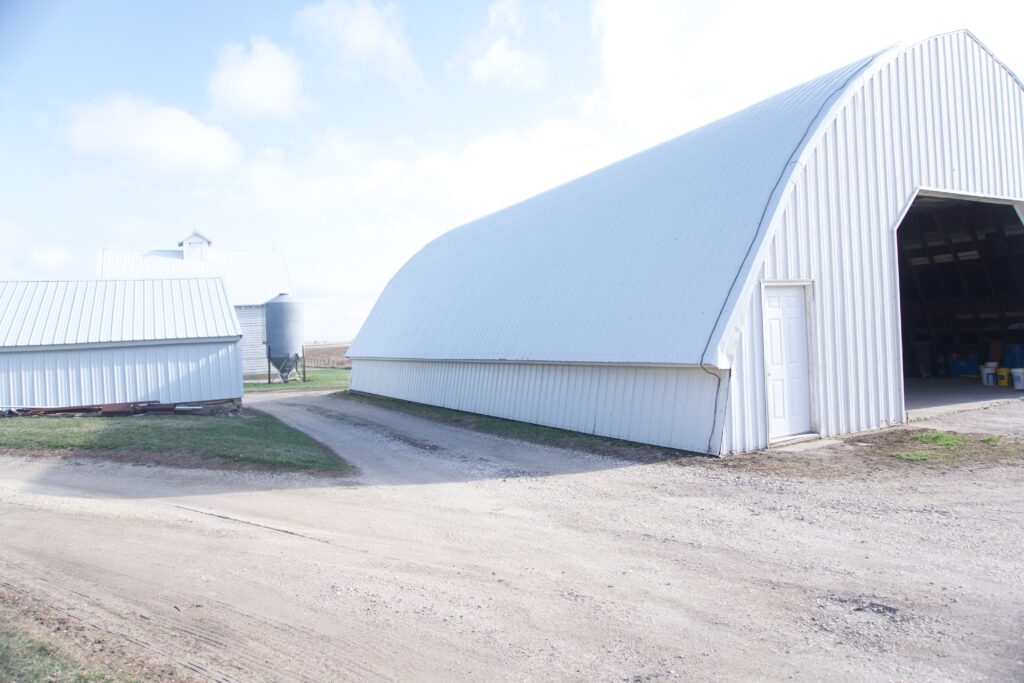
Circle of Blue journalism has an enviable record of accomplishment in elevating important challenges in water supply, scarcity, and availability to civic attention and gaining significant public interest outcomes. Our project on municipal water pricing is regularly cited by mainstream media, academic institutions, and city leaders as an expert source of data. Our work illustrating the confrontation between energy development and water supply in China was influential in negotiating provisions of the 2014 U.S.-China Climate Agreement, the diplomatic breakthrough that led to the 2015 Paris Climate Accord.
Our project on toxic farm discharges has been similarly influential. One of the principal sources for the project is Phoebe Galt, the public information officer for Food and Water Watch, the most active national environmental organization working to end farm pollution. We asked her this week whether our work has been useful.
She responded this way: “Information is power, and Toxic Terrain’s reporting is giving communities on the frontlines of industrial ag and factory farm water pollution just that. With a focused beat, detailed reporting, and a willingness to ask hard questions of entrenched power, your reporting has consistently driven news cycles on critical issues of public health, the environment, and public policy.”
Other sources also commended our work.
“Circle of Blue gives legitimacy to people who say that farm pollution is a real problem,” said Sarah D’Onofrio, a sociologist from the University of Tennessee who investigates agricultural discharges in the Midwest. “We need an eye focused on this so that people recognize that is happening. Circle of Blue has done that. They’ve made it a conversation about water justice, water rights, the ability to have clean water in the future.”
Jim Olson, the dean of Michigan’s environmental law bar, and founder of For Love of Water, a Traverse City-based environmental law and advocacy group, added this: “One of the most effective articles was an early piece in Lenawee County. That was the first major article that exposed how serious the problem is in Michigan. It alerted the larger public to the fact that agriculture enjoyed a free lunch to pollute. The regulatory frame work didn’t work. The article moved the ball. Nobody had written about all that before in this state.”
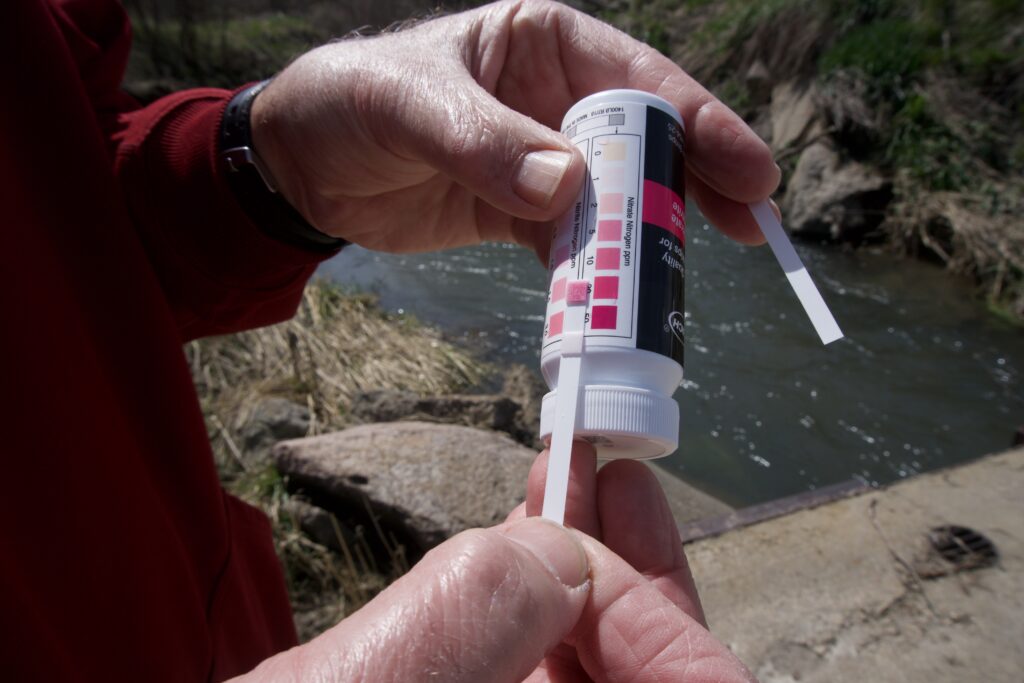
is rampant in Corn Belt waters. Here, a test from Iowa.(Photo/Keith Schneider)
Toxic Terrain’s primary finding is this: Fderal and state lawmakers, heavily lobbied by powerful farm interests, essentially immunized agriculture from environmental and public health safeguards that apply to every other major industrial sector in the country.
That regulatory waiver helped American agriculture evade accountability and avoid the cost of responsible waste management. Allowing agriculture to bypass environmental oversight is one of the primary reasons crop farms and livestock operations are much larger than they were a generation ago, and much more polluting. The result, according to Toxic Terrain articles, is a water quality and public health emergency across Corn Belt states. Surface and groundwater from Minnesota to Missouri, and from Nebraska to Illinois, is heavily contaminated with nitrates. Of the 15 states with the highest cancer incidence five are in the Corn Belt.
From its start Toxic Terrain:
- Was the first to report on how formal fertilizer recommendations made by agricultural universities encourage crop and livestock producers to massively over fertilize farmland.
- Was the first to report on how provisions of the 2022 Inflation Reduction Act are pushing agriculture to the center of U.S. energy production – more corn for ethanol, more methane from manure – that will make pollution worse.
- Was the first to describe the hazards of “digestate,” the byproduct of generating methane from manure biodigesters. Billions of gallons of nitrate-saturated digestate is being spread on farmland without regulatory oversight.
- Was the first to report on how exposure to nitrates in drinking water could be a cause of a cluster of cancers in Minnesota, and rising cancer incidence in Iowa and other Corn Belt states.
- Was the first to report on how the American Farm Bureau Federation is leading a campaign in North Dakota and other states to eliminate local government oversight of large livestock operations.
On a personal note, Toxic Terrain has been one of the toughest projects I’ve tackled in my career. And one of the most rewarding. It’s helping to shape public knowledge of a political and industrial scandal affecting millions of Americans. It’s leading to change, piece by piece. It’s accomplishing what journalism is meant to do. Informing. Elevating an important challenge to wider attention. Prompting action. Thank you for supporting Toxic Terrain.

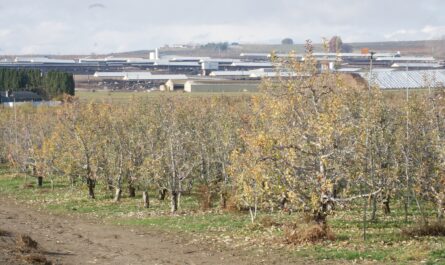
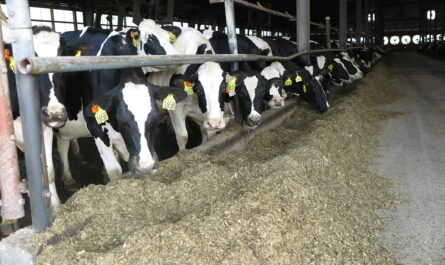
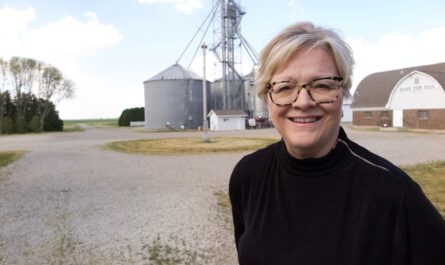
Focused journalism and investigation are essential to build public awareness and action. Stay the course for a better future for our country and world.